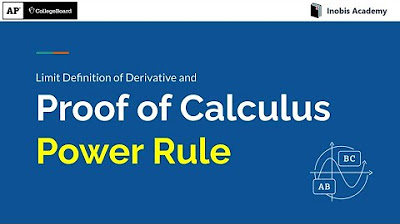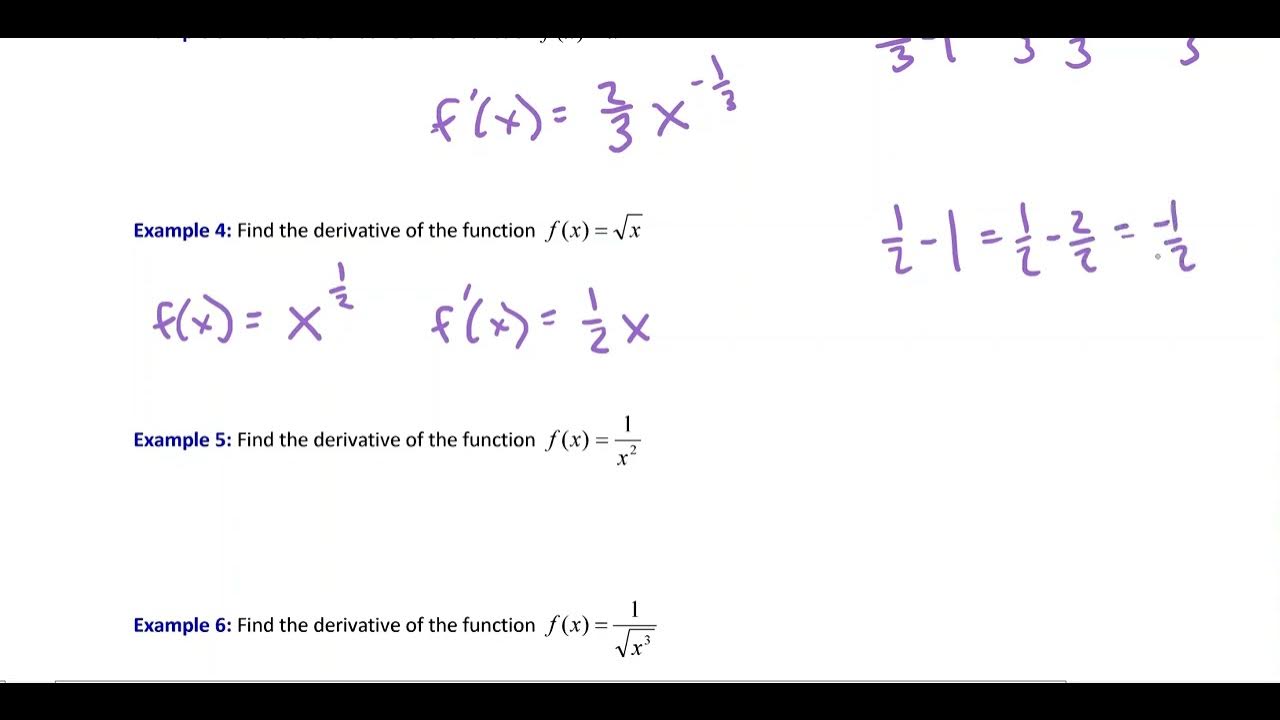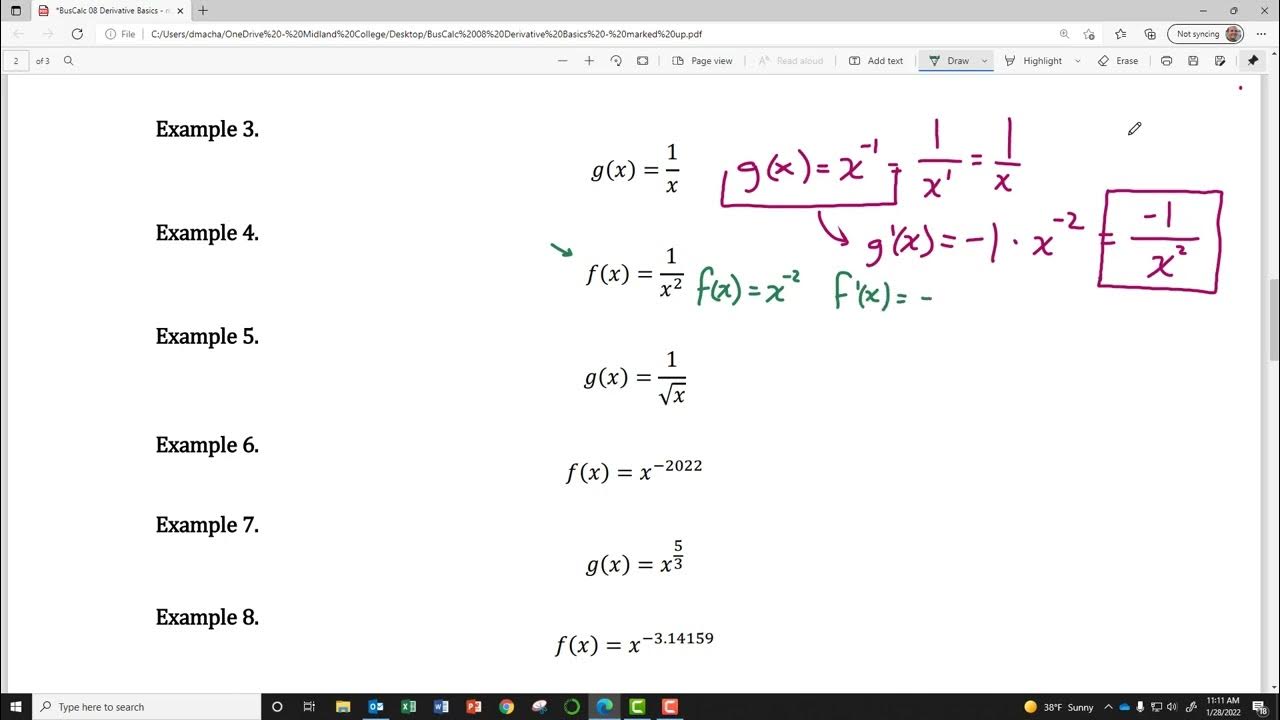Proof: d/dx(x^n) | Taking derivatives | Differential Calculus | Khan Academy
TLDRIn this video, the presenter delves into the mathematical concept of derivatives, specifically focusing on the derivative of x to the power of n. By leveraging the binomial theorem, the video provides a step-by-step explanation of how to derive the general form of a derivative. The presenter simplifies the complex process by canceling out terms and dividing the numerator and denominator by delta x, ultimately proving that the derivative of x^n is n times x^(n-1). This insightful content not only educates viewers on the application of the binomial theorem but also highlights the relevance of understanding fundamental mathematical concepts.
Takeaways
- 📚 The speaker has recently completed a series of videos on the binomial theorem.
- 🧠 Now is the right time to tackle the proof of the derivative of the general form, leveraging the understanding of the binomial theorem.
- 🔜 The classic definition of a derivative is the limit as delta x approaches zero of the function f(x + delta x).
- 🌟 The binomial theorem is essential for expanding (x + delta x)^n and finding the derivative of x^n.
- 📈 The binomial expansion of (x + delta x)^n is utilized to simplify the expression for the derivative.
- 🚫 The proof does not require knowledge of the entire binomial expansion, only the first and second terms are relevant.
- 🌐 When delta x approaches zero, all terms containing delta x in the numerator become zero.
- 🎯 The derivative of x^n is n * x^(n-1), which is a fundamental result in calculus.
- 💡 The proof works for all positive integers and can be extended to real numbers.
- 📝 The binomial theorem, while useful, is not strictly necessary for this proof if one understands the behavior of the terms as delta x approaches zero.
Q & A
What is the main topic discussed in the video?
-The main topic discussed in the video is the proof of the derivative of the general form, specifically taking the derivative of x to the power of n using the binomial theorem.
What is the classic definition of the derivative used in the video?
-The classic definition of the derivative used in the video is the limit as delta x approaches zero of the function f(x) plus delta x, which in this case is f(x) = x to the power n.
How does the binomial theorem help in deriving the derivative of x to the power n?
-The binomial theorem helps in expanding the expression (x + delta x) to the power n, which is crucial for simplifying and finding the derivative of x to the power n.
What is the significance of the term 'n choose 1' in the binomial expansion?
-The term 'n choose 1' in the binomial expansion represents the coefficient of the x to the power (n-1) term and is calculated as n factorial divided by 1 factorial times (n-1) factorial.
What happens to the terms with delta x in them as delta x approaches zero?
-As delta x approaches zero, all terms with delta x in them become zero, because any number multiplied by zero equals zero.
What is the final result of the derivative of x to the power n?
-The final result of the derivative of x to the power n is n times x to the power (n-1), denoted as n * x^(n-1).
Why is it important to divide the numerator and the denominator by delta x?
-Dividing the numerator and the denominator by delta x simplifies the expression and allows for the limit as delta x approaches zero to be taken, which is necessary for finding the derivative.
How does the process of taking the limit as delta x approaches zero affect the terms in the binomial expansion?
-When taking the limit as delta x approaches zero, all terms containing delta x become zero, leaving only the term that does not have delta x, which is the relevant term for the derivative.
What is the role of the binomial theorem in this proof?
-The binomial theorem is used to expand (x + delta x) to the power n, which is essential for identifying the terms that will contribute to the derivative when delta x approaches zero.
How does the proof show that the derivative is valid for all positive integers?
-The proof shows that the derivative is valid for all positive integers by demonstrating that the terms which contain delta x cancel out when delta x approaches zero, leaving a term that is a function of n and x to the power (n-1), which holds true for all positive integer values of n.
What is the implication of the statement that the derivative works for all real numbers?
-The statement implies that the process and the result of the derivative of x to the power n, derived using the binomial theorem, are not limited to integer values of n but are also applicable to real numbers, expanding the utility of the proof.
Outlines
📚 Derivation of the General Power Rule
This paragraph introduces the process of deriving the general power rule for the derivative of x to the n, utilizing the knowledge of the binomial theorem. The explanation begins with the classic definition of a derivative and applies it to the function x^n. By expanding (x+Δx)^n using the binomial theorem, the derivative is found to be n*x^(n-1). The derivation is shown step by step, highlighting the cancellation of terms and the simplification process as Δx approaches zero. The importance of the binomial theorem in this proof is emphasized, and viewers are directed to review the theorem for a better understanding.
🧮 Simplification and Implications of the Power Rule
The second paragraph delves into the simplification of the power rule and its implications. It explains the concept of factorial and how it relates to the power rule, simplifying the expression to n times x^(n-1). The explanation clarifies that the derived rule is valid for any positive integer value of n and hints at its applicability to all real numbers. The paragraph also discusses the relevance of the binomial theorem in the proof and suggests that while it's beneficial to understand the theorem, one could potentially deduce the rule through observation and experimentation. The paragraph concludes by reassuring viewers that the proof is complete and anticipates future discussions on the topic.
Mindmap
Keywords
💡Binomial Theorem
💡Derivative
💡Limit
💡Delta x
💡Power
💡Numerator
💡Binomial Coefficient
💡Factorial
💡Simplify
💡Difference Quotient
Highlights
The speaker begins a new video on the proof of the derivative of the general form, specifically focusing on the derivative of x to the power of n.
The binomial theorem is mentioned as a crucial tool for understanding this proof, suggesting that the audience should be familiar with it for a better grasp of the content.
The classic definition of the derivative is introduced, which involves the limit as delta x approaches zero of the function f(x).
The process of taking the derivative is explained, starting with the binomial expansion of (x + delta x) to the power of n.
The binomial theorem is utilized to expand (x + delta x) to the nth power, with a detailed explanation of the resulting terms.
The cancellation of terms in the numerator and denominator when delta x approaches zero is discussed, leading to the simplification of the expression.
The final result of the derivative of x to the power of n is derived as n times x to the power of n minus 1.
The proof is noted to be valid for all positive integers, and a hint is given that it extends to all real numbers for the exponent.
The importance of the binomial theorem in this proof is reiterated, but it's also mentioned that it's possible to understand the proof with basic knowledge of binomial expansions.
The speaker emphasizes that the key terms in the binomial expansion are the ones relevant to the proof, as the rest cancel out when delta x approaches zero.
The concept of n choose 1 and its simplification to n is explained, providing insight into the mathematical process of the proof.
The speaker invites the audience to watch future videos for more on this topic, indicating a continuation of the discussion.
A brief mention of the app's pre-calculus playlist is made, directing the audience to additional resources for understanding the binomial theorem.
The process of dividing the numerator and denominator by delta x is described, which is a crucial step in the simplification of the derivative expression.
The limit concept is applied to the derivative calculation, emphasizing the approach of delta x to zero and its impact on the terms of the binomial expansion.
The speaker provides a clear and methodical walkthrough of the proof, making complex mathematical concepts accessible to the audience.
Transcripts
Browse More Related Video

Proof of the Calculus Power Rule using the Limit Definition of a Derivative.

Proof: d/dx(sqrt(x)) | Taking derivatives | Differential Calculus | Khan Academy

Basic Derivative Rules - Part 1

DERIVATIVE OF RADICAL: THE CHAIN RULE

BusCalc 08 Derivative Basics

Power rule introduction (old) | Taking derivatives | Differential Calculus | Khan Academy
5.0 / 5 (0 votes)
Thanks for rating: